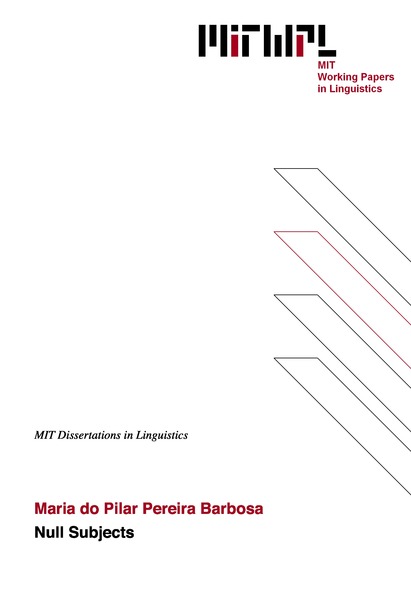Null Subjects
Author: M. d. P. P. Barbosa, Year:1995
<
p>The goal of this thesis is to isolate the properties that characterize the languages that show a correlation between the possibility of dropping a subject and rich subject verbal agreement morphology. I will propose an articulated structure for TP, which is meant to reflect, in binary terms, the relation established among the Speech time, the Reference time and the Event time, the basic primitives of tense in Reichenbachian theories of tense. I will suggest that TP is broken down into a projection of “Tense relative to the Event time” (TE) and a projection of “Tense relative to the Speech time” (TS). The former corresponds to the standard IP and is the locus of the Extended Projection Principle. Spec-TS is an A-bar position. In subordinate clauses TPS is selected by C. I will argue that the Null Subject Property is the result of the combination of the following two properties: overt V-to-TE-to-TS and a sufficiently rich bundle of nominal agreement features on V capable of checking off the Nominative Case feature of TE and the EPP. The configuration of c-command established between the bundle of nominal features in TS and an empty D in Spec-TE will be argued to be essential to the Null Subject Property. Overt V-to-TE-to-TS raising will also be argued to be a property of a standard VSO language such as Irish. The differences between Irish and the Romance Null Subject languages with respect to word order follow from the fact that Irish has no agreement inflection. TE raising to TS accompanied by subject raising to Spec-TPE yields VSO order.
Thesis Supervisors: Noam Chomsky, Institute Professor, and Alec P. Marantz, Associate Professor
1.1
7
The subject matter
1.2
11
Organization of the thesis
1.2.1
11
Chapter 2: Preverbal subjects in the Romance Null Subject languages
1.2.2
11
Chapter 3: The split TP hypothesis
1.2.3
12
Chapter 4: Subject drop, agreement and inversion
<br/>
2
13
Preverbal subjects in the Romance NSLs
2.1
14
Clitic left dislocation and Focus movement (Cinque 1990)
2.1.1
15
Focus movement, CLLD and bare QPs
2.1.2
24
Summary of section
2.2
26
Preverbal subjects in the Romance NSLs
2.2.2
28
Fiorentino and Trentino: a case study
2.2.3
35
Indefinite subjects
2.2.4
39
ne-cliticization
2.2.5
49
Bound variable readings of overt pronouns
2.2.6
51
Emphatic pronouns
2.2.7
56
Relative clause extraposition
2.3
64
Conclusion
<br/>
3
65
The split TP hypothesis
3.1
68
Lexical subjects in nonfinite environments
3.1.1
68
Infinitivals and gerunds: an overview
3.1.2
73
Generalized Asp/T raising in null subject Romance absolute clauses
3.1.3
95
Summary of section
3.2
96
Finite clauses
3.2.1
97
Evidence for the Aʹ status of the specifier position of the head to which the verb uniformly raises in the NSLs
3.2.2
122
The nature of the intermediate projection between CP and IP
3.3
138
Tense morphemes in Irish
<br/>
4
143
Subject drop, agreement and inversion
4.0
143
Introduction
4.1
143
Irish clause structure (McCloskey 1994)
4.1.1
148
Some modifications to McCloskey 1992: Irish lacks Agr
4.1.3
153
Salient and Putative unaccusatives revisited
4.1.4
160
Summary of section
4.2
160
Diachronic evidence for a c-command relation between agreement and pro in Spec-TE
4.2.1
161
Old French (Adams 1987)
4.2.2
164
The evolution of the dialects of northern Italy
4.3
166
Clitic-like agreement
4.4
169
Postverbal subject constructions
4.5
175
Concluding remarks
<br/>

